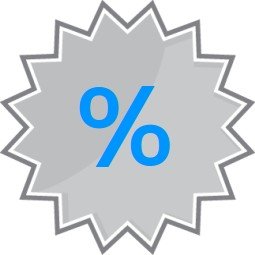Introduction to Percents!
Understanding percents is a fundamental skill that you’ll use in everyday life, from calculating discounts while shopping to interpreting statistics in the news. This lesson is designed to give you a good introduction and help you explore the topic with real-life applications, ensuring you build a strong foundation for more advanced mathematical concepts.

What is a Percent?
A percent is a way to express a number as a fraction of 100. The word "percent" comes from the Latin per centum, meaning "by the hundred." It’s represented by the symbol %. For example:
- 50% means 50 out of 100, or simply half.
- 25% means 25 out of 100, which is one-quarter.
Visual Example: Imagine a pizza divided into 100 equal slices. If you eat 25 slices, you’ve eaten 25% of the pizza.
Converting Between Percents, Fractions, and Decimals
Understanding how to convert between these forms is essential for working with percents.
- Percent to Fraction:
Example: 75% = 75/100 = 3/4 - Percent to Decimal:
Example: 20% = 0.20 - Fraction to Percent:
Example: 1/5 = 20% - Decimal to Percent:
Example: 0.85 = 85%
Quick Tip: To convert a percent to a decimal, divide by 100. To convert a decimal to a percent, multiply by 100.
Basic Percentage Calculations
Let’s explore how to perform some basic percentage calculations.
Finding a Percentage of a Number:
Formula: Percentage × Number
Example: What is 30% of 200?
Calculation: 0.30 × 200 = 60
Increasing a Number by a Percentage:
Formula: Number + (Percentage × Number)
Example: Increase 150 by 10%
Calculation: 150 + (0.10 × 150) = 165
Decreasing a Number by a Percentage:
Formula: Number - (Percentage × Number)
Example: Decrease 80 by 25%
Calculation: 80 - (0.25 × 80) = 60
Real-Life Applications of Percents
Percents are everywhere! Here are some common scenarios where you’ll use percents:
1. Shopping Discounts:
- Example: You may have heard people say that they will give you a 5% discount if you purchase two T-shirts or five pants. If a jacket is marked down by 20% and the original price is $50:
- Discount: 0.20 × 50 = $10
Sale Price: $50 - $10 = $40
2. Earnings and Jobs:
- Example: Some jobs, such as car sales, pay based on a percentage of sales. If a car salesperson earns a 10% commission on a $20,000 car sale:
- Commission: 0.10 × 20,000 = $2,000
3. Savings and Interest:
- Example: If you have a savings account, the bank may give you a 3% interest every year. Say you have $1,000 in savings account:
- Interest: 0.03 × 1,000 = $30
Total After One Year: $1,000 + $30 = $1,030
4. Credit and Loans:
- Example: Credit card companies charge high interest of 10% to 20% depending on your credit. If you owe $500 on a credit card with a 15% interest rate:
- Interest: 0.15 × 500 = $75
Total Owed After One Year: $500 + $75 = $575
A review of fractions and proportions may help you understand this unit. Therefore, go back and review them if time permits.
Have A Great Math Problem About Percentage?
Share your problem here along with the solution!
What Other Visitors Have Said
Click below to see contributions from other visitors to this page...
A percent word problem 



A factory has 800 workers. 40% of them are females. The management decides to employ more female workers to cope with the increasing demands of the workload …